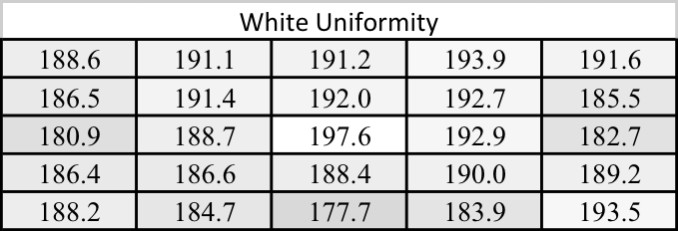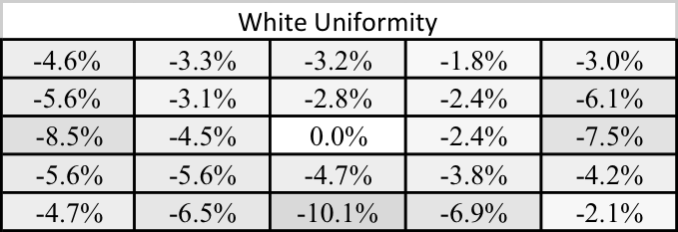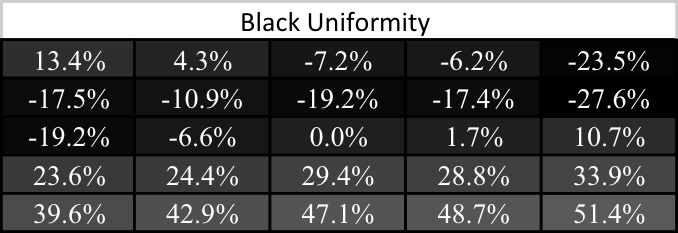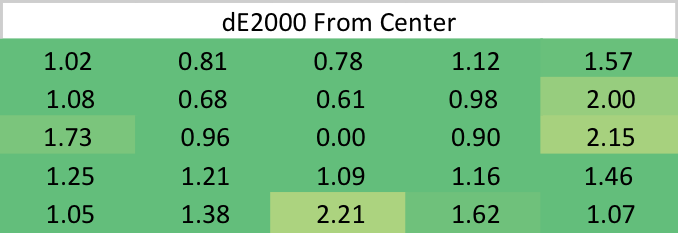The 9.7" iPad Pro Review
by Brandon Chester on June 1, 2016 9:00 AM ESTDisplay Uniformity
With Apple billing the 9.7" iPad Pro as a professional device with individually calibrated displays, I felt it was relevant to bring our uniformity test over to mobile. While we usually just measure errors at the center of a display, there are also errors across the panel itself due to inconsistencies in the panel and the backlighting array. This means that a display can be accurate at the center, but the edges can have significant luminance dropoff or gain that makes the display unsuitable for any sort of image work due to the fact that there are visible color differences across the display itself. For this test we use an array of 25 points on the display and measure the accuracy of colors in the GretagMacbeth ColorChecker test, as well as the uniformity of the white and black levels at each spot.
While I don't have any other mobile devices for reference, if I were evaluating the 9.7" iPad Pro as a professional monitor I would say that the white uniformity is decent, but not amazing in any regard. The central area of the display is fairly uniform, but there's noticeable dropoff on the left, right, and bottom edges. This is something I see on a number of phones and tablets, and maintaining uniformity probably hasn't been a concern for vendors until this point, but I'm hoping that a larger focus on it will make companies put more focus on it as a selling point for professional devices.
Black uniformity on the 9.7" iPad Pro isn't great. If you divide the display along its diagonal from the top right to bottom left corners you see that the in general the bottom section has higher black levels, while the top has lower black levels. In general, the black level isn't as dark at the edges as it is in the center. Black levels and contrast are the areas where Apple's LCDs really can't compete with Samsung's AMOLEDs, and with the 9.7" iPad Pro falling pretty far behind its bigger brother with black levels Apple should put more focus on at least keeping their blacks consistent across the display.
While the black uniformity isn't great on the 9.7" iPad Pro, and the white uniformity is just okay, the uniformity for colors is outstanding. There are a few hot spots on the edges, but in general the error relative to the center is well under two, and often near or even below one. I'm surprised that Apple has such uniform color rendition, as an uneven luminance level will usually throw off colors much more severely. Whatever the case may be, you can at least depend on even color rendering across the 9.7" iPad Pro's display.















144 Comments
View All Comments
dannyzhukovets - Thursday, June 2, 2016 - link
Thank you very much for this review. iPad is a work tool for me, use is in my semi-truck.Replaced my iPad 3 (the first iPad with retina display) with this new 9.7 Pro and gut disappointed again. Paid $1030 for top version to find out that it lacks RAM and won't be a great long term investment like I desired from a product with Pro tag.
Thinking to update to iOS 11 later this year and then refuse to update to iOS 12 in 2017 and after...
Commodus - Sunday, June 5, 2016 - link
Yeah, you won't want to pour a ton of money into the iPad Pro unless you know it'll be your only mobile computer and you specifically need as much storage or connectivity as possible.Also, I think you mean iOS 10, given that we're still on iOS 9... unless you've found a way to travel a year into the future.
grayson_carr - Thursday, June 2, 2016 - link
Love the display uniformity tests! Thank you! It always makes me mad that Samsung's AMOLED displays get great marks for calibration, but no one mentions or tests their uniformity. Spoiler! They have terrible uniformity! Most S6 and S7 samples I have come across have white uniformity so bad that the unevenness can be seen with the naked eye in the form of pink or green tints across portions of the displays. It would be cool if you could retroactively test the uniformity of a couple recent Samsung phones.Brandon Chester - Thursday, June 2, 2016 - link
I forgot to mention this but it's impossible to do on a phone beyond something like a four corner test. The meter is too big relative to the display. When the next Samsung tablets roll around I will definitely be using this test, so keep your eyes open.grayson_carr - Monday, June 13, 2016 - link
Aw, dang. Makes sense. I still think a simple 4 corner test would be useful though.GC2:CS - Friday, June 3, 2016 - link
It would be deffinitelly good to make some broader tests.I actually heard that oleds have near perfect uniformity considering they lack the backlight that is bassically causing that problem. Might be kind of poor argument as I don't think that laying down oled sandwiches is perfect either... And differently aging colors can take a big tool in this metric over time for sure.
AbRASiON - Saturday, June 4, 2016 - link
WARNING:I picked up one of these 3 weeks back, I happen to use it in bed, at night, quietly. It's how I like to go to sleep.
In a silent room, you can CLEARLY hear the buzz of the LCD driving chip, just put your eat right where the volume rocker is in a very quiet environment, then scroll the screen with your hand. It's quite annoying.
My Air 2, didn't do this.
Brandon Chester - Saturday, June 4, 2016 - link
I have it on the table next to me and there's no noise. You might want to get it replaced.R. Hunt - Monday, June 6, 2016 - link
Say what you will, I'm never going back to LCD on a tablet, no matter how good. They're still crap.grayson_carr - Monday, June 13, 2016 - link
Why? Because they don't make photos look like they were taken in a neon cartoon world like AMOLED screens do?